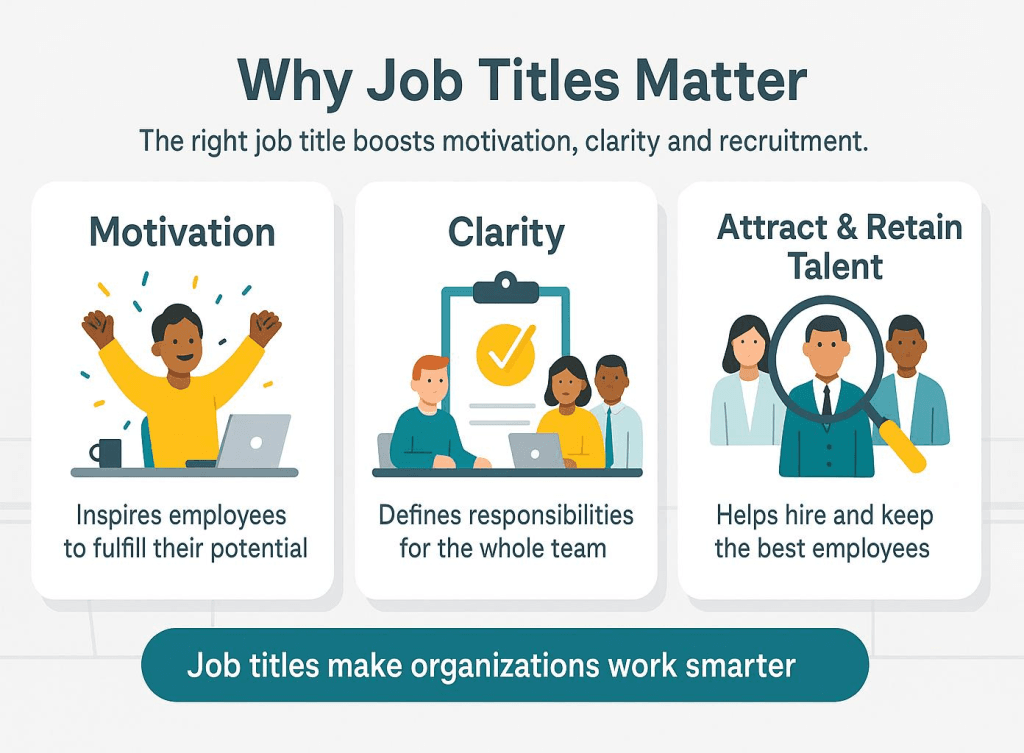Business.com aims to help business owners make informed decisions to support and grow their companies. We research and recommend products and services suitable for various business types, investing thousands of hours each year in this process.
As a business, we need to generate revenue to sustain our content. We have financial relationships with some companies we cover, earning commissions when readers purchase from our partners or share information about their needs. These relationships do not dictate our advice and recommendations. Our editorial team independently evaluates and recommends products and services based on their research and expertise. Learn more about our process and partners here.
How to Choose a Job Title
Good job titles can help you attract top talent, increase employee motivation and satisfaction, and build an organizational structure.

Table of Contents
Hiring a new employee is a detailed process that requires various steps and decisions. You must define your new team member’s roles and responsibilities, write a clear and accurate job description, and build a competitive compensation package. However, you may make the mistake of not carefully and thoughtfully determining the new team member’s job title.
Although some people may tell you that job titles don’t matter, particularly at a startup, research shows they do. If you’re in the process of staffing your business or managing your startup’s organizational structure, read on to learn how to choose a job title and see common job titles you may want to consider for your business.
How to choose a job title

Choosing the right job title can be tricky, especially when determining the title for a position that encompasses multiple roles and responsibilities. However, every employer should take the time to develop a thoughtful strategy for naming positions and assigning titles, regardless of the company’s size.
Here are best practices for choosing accurate job titles that incorporate the many hats worn by your employees.
1. Develop a consistent system early.
Although every business uses titles in distinct ways to meet unique needs, it’s essential to develop a system for generating titles early on. Being consistent with the way titles are formed helps avoid confusion and disparities, especially among employees who hold multiple roles and those who may have similar responsibilities but end up with different titles.
Marielle Smith, head of people operations at Material Security, told us she advises asking the following questions when developing job titles:
- How will this title help this person do their job effectively?
- How will this title be perceived externally by customers, partners and future employers?
- How does this title fit into our overall organizational structure and career progression paths?
- What will the next logical promotion title be?
By honestly answering these questions, business leaders can create a framework for titles that is uniform and responsive to their organization’s specific needs while focusing on employees’ career development and professional growth.
2. Link titles to primary responsibilities.
When employees have multiple responsibilities in an organization, but most of their day-to-day functions fall within one particular department, it makes sense to link their title to that specific business area. Stephanie Troiano, an executive recruiter at Wimbush & Associates Inc., recommends that employers start by understanding the most critical aspects of their staff’s position.
“Think … first in general terms in order to come up with an umbrella title or department that they can fall into,” Troiano said. “The idea is to try and categorize their duties and position broadly, then narrow down from there.”
3. Consider employee input.
When struggling to find the ideal title for the employee who does it all, businesses can take the pressure off by realizing that the decision doesn’t have to be solely their own. Companies can empower staff to select their own job titles. After workers have been in a role for a trial period and know what the position involves, you can encourage them to name their own jobs within agreed-upon parameters.
“We have found great success in letting our employees figure out what kind of job title they would like to have and present us with their name choice and reasoning behind it,” said Deborah Sweeney, president of Deluxe Corporation. “Then, we decide if it is a fit for them or not.”
4. Avoid overly creative titles.
When an employee does it all, it may be tempting to come up with a fun and whimsical title that encompasses the spirit, if not the content, of their job. While there’s a time and place for unique and creative titles — Disney employs “Imagineers,” and VaynerMedia has a chief heart officer — it’s crucial to consider how these titles will be perceived outside the company and translated to other workplaces.
A unique title that’s empowering within one organization may seem vague or unclear to clients, recruiters, job seekers and other firms. An unclear title can ultimately hinder the employee and your business. For example, calling someone a “crisis ninja” or “in-house philosopher” raises questions rather than provides answers about what the titleholder does.
Smith also said that companies must consider whether the titles they create will reflect well on the business now and in the future. For instance, consider what the next job title will be as your staff is promoted.
“As the company matures, they will want to attract top talent, and senior talent often want titles that reflect their hierarchy within the company or they’ll find the title and position they want somewhere else,” Smith cautioned.
5. Steer clear of title inflation.
All your employees are critical, especially if you’re a small operation, and you want their titles to carry the weight of their value. But it’s a poor business decision to have five vice presidents in a company of six people just so everyone feels good. Consequently, companies should steer clear of title inflation, even when trying to recognize the multidimensional roles of staff members.
Although it’s cheaper to hand out fancy titles than give out raises, there are often unintended consequences when titles are doled out with ease. Title inflation can lead to tension among colleagues and employees who suddenly feel their old responsibilities are beneath their new titles. Often, the best policy is to keep it simple and pass over the impressive-sounding titles in favor of logical ones that speak directly to the needs and goals of your organization.
Learn more about common job title mistakes below.
Common job titles and levels
In a traditional organization, you can expect a hierarchy of employees in executive roles, middle and first-level management, and intermediate and entry-level roles. Depending on your company’s needs, you may even have a board of directors. Here are some common business job titles and what their positions entail.
Executive level (C-suite)
Excluding a board of directors, the C-suite is the highest level of the organizational hierarchy. These employees are senior executives responsible for big-picture thinking. Standard C-suite job titles can include:
- Chief executive officer (CEO)
- Chief operating officer (COO)
- Chief financial officer (CFO)
- Chief marketing officer (CMO)
- Chief product officer (CPO)
- Chief information officer (CIO)
Middle management (VPs and directors)
The following level in the chain of command includes the organization’s vice presidents (VPs) and directors. These employees are considered middle management and often lead entire departments. To create a title at this level, you can pair the term “vice president” or “director” with the name of the employee’s department. For example, you may have a:
- VP of production
- VP of operations
- Director of marketing
- Sales director
First-level management (managers and supervisors)
Below the VPs and directors are managers and supervisors; these employees are considered first-level management. While managers may oversee some employees or a subdepartment, they typically are also responsible for day-to-day operations.
Common manager titles you can expect to see at a startup include the following:
- Accounting manager
- Customer success manager
- Engineering manager
- Human resources manager
- Marketing manager
- Operations manager
- Product manager
- Project manager
- Quality assurance manager
- Sales manager
- Social media manager
Individual contributors
Individual contributors can consist of entry-level, intermediate and experienced staff. These employees are responsible for day-to-day projects and assignments. As the title indicates, these individuals contribute to the organization’s success through independent work and don’t typically manage other people.
Industry-specific job titles
Different startup sectors require unique approaches to job title strategy, reflecting industry norms, regulatory requirements and talent pool expectations.
Technology startups
Tech startups often benefit from clear, technically descriptive titles that immediately communicate expertise level and specialization. Common effective patterns include:
- Engineering roles: Software engineer I/II/III, senior/staff/principal engineer, engineering manager
- Product roles: Product manager, senior product manager, director of product
- Data roles: Data scientist, machine learning engineer, analytics manager
Avoid overly creative tech titles like “Code Wizard” or “Data Ninja” that may not resonate with experienced professionals or enterprise clients.
Retail and e-commerce startups
Retail startups should align with established industry terminology while allowing for growth. For example:
- Operations roles: Fulfillment manager, supply chain coordinator, inventory specialist
- Customer-facing roles: Customer success manager, sales associate, brand ambassador
- Marketing roles: Digital marketing manager, social media specialist, content creator
These titles translate well when hiring from established retail companies and working with suppliers or partners.
Service-based startups
Professional service startups often benefit from titles that convey expertise and authority to potential clients. We recommend:
- Consulting roles: Senior consultant, practice lead, engagement manager
- Financial services roles: Investment analyst, portfolio manager, relationship manager
- Healthcare roles: Clinical coordinator, patient advocate, quality assurance manager
Professional credentials and regulatory requirements particularly matter in service industries.
Highly specialized startups
Highly specialized startups should use titles that reflect technical expertise while remaining accessible. These include:
- Research roles: Research scientist, principal investigator, lab manager
- Regulatory roles: Regulatory affairs specialist, quality manager, clinical research associate
- Technical roles: Bioprocess engineer, computational biologist, systems engineer
These industries often require specific educational backgrounds and certifications that should align with title expectations.
Legal considerations for job titles
Before assigning job titles, startup founders and business owners must understand the legal landscape surrounding employment titles. The Equal Employment Opportunity Commission (EEOC) prohibits employers from using job titles or employment policies that disproportionately negatively affect applicants or employees based on protected characteristics, including race, color, religion, sex, national origin, age, disability or genetic information.
Key legal considerations include:
- Title discrimination prevention: Ensure job titles don’t inadvertently suggest preferences for specific demographics. For example, using terms like “digital native” might discriminate against older workers, while “rockstar” or “ninja” could create cultural barriers.
- Equal pay compliance: Under the Equal Pay Act, employees performing substantially equal work should receive equal compensation regardless of their title. Avoid using different titles for the same role solely to justify pay disparities.
- Professional licensing requirements: In most states, using the word “psychologist” in a job title requires board certification and licensure, and is more applicable to clinical positions. Similarly, titles like “engineer,” “architect” or “attorney” may require specific professional credentials in certain jurisdictions.
Common job title mistakes
Learning from others’ missteps can help startups avoid costly hiring and retention problems. Here are the most frequent job title mistakes and their real-world impacts.
The premature “VP” problem
A common startup mistake involves hiring a “VP of Sales” when the company actually needs someone for customer development and market validation. This mismatch occurs because traditional sales roles assume:
- A repeatable and scalable business model
- A well-understood group of customers
- Standard corporate presentations and pricing
- Established sales processes
Early-stage startups lack these foundations. Instead, business owners need executives comfortable with learning and discovery rather than pure execution, who can handle daily change while operating without a clear roadmap. Otherwise, expect high executive turnover, failed customer acquisition strategies and wasted resources on inappropriate sales infrastructure.
Title inflation disasters
Startups that hand out senior titles too early face several problems, including:
- External credibility issues: When a six-person company has five VPs, clients and investors question leadership judgment.
- Internal hierarchy confusion: Employees struggle to understand reporting structures and advancement paths if job titles don’t clearly state seniority.
- Future hiring difficulties: Attracting experienced executives becomes impossible when junior staff already hold senior titles.
- Compensation compression: Limited room for meaningful title promotions forces reliance on expensive salary increases.
The “creative title” trap
While unique titles like “chief happiness officer” or “marketing rockstar” may seem engaging internally, they create external challenges:
- Recruiting barriers: Experienced professionals may dismiss unclear or juvenile-sounding roles.
- Business development obstacles: Enterprise clients may question dealing with “ninjas” and “gurus” for serious business matters.
- Career mobility problems: Employees struggle to translate creative titles when seeking new opportunities.
- Professional network limitations: Industry connections may not understand or respect non-standard titles.
Regulatory and compliance failures
Some business owners and startups inadvertently create legal risks through poor title choices. Be aware of:
- Professional licensing violations: Using protected titles without proper credentials
- Discrimination implications: Titles that suggest age, gender or cultural preferences
- Misclassification risks: Using “consultant” or “contractor” titles for employees
- Securities compliance: Improperly using “investment” or “advisory” titles without proper registrations
Industry misalignment
Failing to match industry norms can signal inexperience. For example:
- Healthcare startups using “patient success ninja” instead of “clinical coordinator”
- Fintech firms with “money managers” instead of “portfolio analysts”
- Enterprise software companies featuring “customer happiness engineers” instead of “Technical Account Managers”
Misaligned job titles may lead to difficulty attracting experienced industry talent and establishing credibility with sector-specific clients and partners.
Why job titles matter

Recent academic research reinforces the importance of thoughtful job title selection. According to Gallup’s 2024 workplace data, only 33 percent of employees are engaged in the workplace, and “not engaged or actively disengaged employees account for approximately $1.9 trillion in lost productivity nationally.” Job titles and role clarity play a crucial role in this engagement equation, as they directly impact how employees perceive their value within the organization and their career progression potential.
Studies referenced in the IIMT Journal of Management in 2024 show that employee engagement influences “well-being, increased life satisfaction, retention and less turnover intention.” This can also reduce the risk of burnout. When employees feel their titles accurately reflect their contributions and provide growth opportunities, they demonstrate higher levels of commitment and performance.
Here are the biggest reasons job titles are so crucial:
- Job titles can attract top talent: Clear, professional titles help qualified candidates find and understand your opportunities. Organizations with proper title structures and clear career progression paths experience higher employee engagement and retention rates.
- Job titles boost external credibility: Professional titles help establish credibility with clients, partners and investors who expect to work with appropriately positioned team members.
- Job titles influence employee motivation and satisfaction: Appropriate titles validate employees’ contributions and provide a sense of professional identity and pride in their work.
- Job titles impact organizational structure: Well-defined titles create clear reporting relationships, decision-making authority and career progression paths.
- Job titles affect legal compliance: Proper titles help ensure compliance with employment laws, professional licensing requirements and industry regulations.
- Job titles support Internal communication: Clear titles help team members understand colleagues’ roles, expertise areas and appropriate points of contact for different issues.
- Job titles guide performance management: Titles tied to specific responsibilities make it easier to set goals, measure performance and provide targeted development opportunities.
Adapting job titles as your business grows
It’s important to note that job titles are not a one-and-done deal, particularly when it comes to startup job titles. As your company expands and employees flourish in your organization, new job titles may emerge as your team members’ career paths take shape. Business owners should follow these tips for implementing and auditing job titles as their business grows:
- Plan for progression: Design initial titles with future growth in mind. A “marketing coordinator” can naturally advance to “marketing manager” and eventually “director of marketing.”
- Enact regular review cycles: Assess titles during performance reviews and as the company reaches new milestones (funding rounds, revenue targets, team size thresholds, etc).
- Confirm market alignment: As your startup matures, ensure titles remain competitive with industry standards to retain talent and attract experienced hires.
- Be open to role evolution: Be prepared to modify titles as job responsibilities change, departments restructure or new functions emerge.
The key is maintaining the balance between recognizing employee growth, supporting business needs and preserving organizational credibility as your business scales.
Jamie Johnson contributed to this article. Source interviews were conducted for a previous version of this article.











